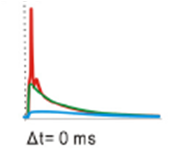Anonymous asks:
"Are there any known transmitters in the NS that activate both inhibitory receptor subtypes AND excitatory receptor subtypes? Or does every known transmitter activate EITHER a bunch of excitatory subtypes OR a bunch of inhibitory subtypes?"(btw. This doesn't qualify as a LMAYQ post because it's a real true question that someone directly asked, not a search term)
While I don't know of any instances of glutamate (excitatory) activating GABA (inhibitory) receptors or of GABA activating glutamate receptors, there is an interesting little way that GABA can activate an inhibitory receptor, but actually help excite the cell.
 |
| GABA receptor (source) |
Here's how that works: GABA(A) receptors are permeable to chloride ions, and as the picture above shows, chloride ions (Cl-) are negatively charged. When GABA binds to the receptor, the receptor opens and chloride ions rush in, bringing their negative charge with them. This hyperpolarizes the cell, meaning it brings it lower and lower in total charge (membrane potential), which brings it further and further away from the threshold where it will fire an action potential.
BUT.... if there is a lot of chloride inside the cell already (or if the cell is resting more negatively than the chloride reversal potential), chloride will actually flow out of the cell, bringing its negative charge with it. Negative ions flowing out of the cell will depolarize the neuron increasing its total charge (membrane potential), which brings it closer and closer to the threshold where it will fire an action potential.
 |
| GABA reversing at -62mV (source) |
A paper published last year in the Journal of Neuroscience shows that in a model of a hippocampal neuron, when a strong excitatory (glutamate) stimulation happens right after a GABA stimulation close by on the dendrite, the cell is actually more likely to fire than when the glutamate stimulation occurs on its own. This effect is dependent on the location of the GABA stimulation along the dendrite.
 |
| Chiang et al., 2012 Figure 4E (GPSP in the dendrite) |
This figure shows that a GABA stimuation (first dotted line, blue trace) can push the glutamate (excitatory) stimulation (second dotted line, red trace) up to the point of firing an action potential (green trace). This paper also showed that GABA can still inhibit the action potential in these cells, it just has to be at the soma and almost the same time as the glutamatergic input.
 |
| Chiang et al., 2012 Figure 4G (GPSP in the soma) |
So there you have it, GABA enhancing the likelihood of an action potential and acting excitatory sometimes, and acting inhibitory other times.
© TheCellularScale


















